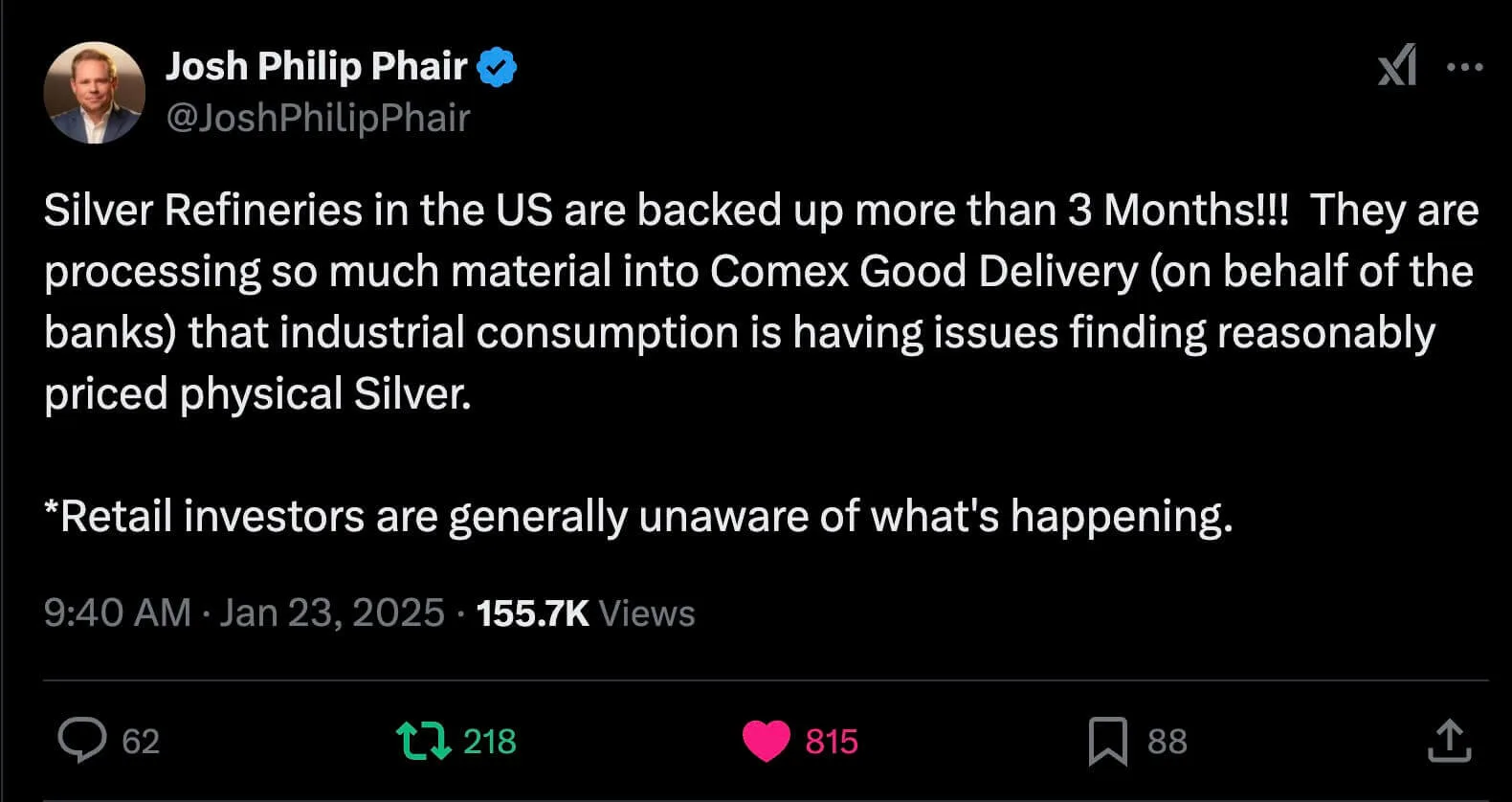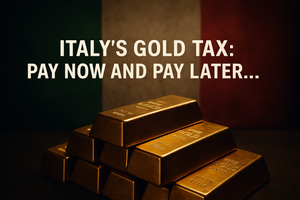The following is a summary of the video:
State of the Precious Metals Market: Industry Insights from Scottsdale Mint
Introduction and Background in Precious Metals
I recently posted my first video in a while on X (formerly Twitter). Starting with zero followers, I’ve gained some traction, and I wanted to share more content about my background and current market insights.
I’ve been in the precious metals industry for 16 years, founding and running Scottsdale Mint. Before that, I worked in Hard Rock mining, managing risk for some of the world’s largest gold, silver, and copper mining companies. While I wouldn’t say I was the smartest guy in my 20s, I was sharp at identifying problems and bringing solutions for risk mitigation to mining companies. This included everything from secure transport of gold and silver from Mexico or Bolivia to refineries, to managing trade credit, political risk, construction projects, and environmental issues in various Latin American countries.
The Birth of Scottsdale Mint
During the 2008 financial crisis, the precious metals landscape changed dramatically in the United States. With silver becoming particularly difficult to acquire, I launched Scottsdale Mint from my guest bedroom, leveraging my industry relationships. Today, we manufacture legal tender coinage in gold and silver for approximately 20 foreign central banks and nations. We supply hundreds of wholesalers worldwide with investment products, collectibles, and licensed products – many of which don’t carry our name. In fact, you might see people on TV promoting products that we produce without our branding.
Strategic Move to Wyoming
Why Wyoming?
In 2022, I relocated my family to Wyoming to take the company to the next level. Wyoming represents what America used to be and is currently the #1 ranked sound money state. For a business, this means consistency. I know many of the politicians, and they’re very supportive of minerals.
Wyoming is the second-largest energy exporter in the US after Texas, with significant resources in:
– Natural gas and oil
– Wind energy
– Uranium (#1 state)
– Coal (#1 state)
– Nuclear developments (including Bill Gates and Warren Buffett’s new plant)
– Rare Earth minerals
– New uranium enrichment facilities
There’s a huge arms race for critical minerals, and Wyoming is positioned to be a crucial player with two pilot plants currently under construction.
Company Expansion
Our new facility in Wyoming will span approximately 70,000-80,000 square feet when completed. The majority of our team relocated last fall, marking an exciting new chapter for the company. While we appreciate our roots in Scottsdale, we’re very excited about our new home in Wyoming.
The Wyoming Reserve: A New Venture
I’ve also established a new vaulting company called the Wyoming Reserve. This isn’t just a typical vaulting operation – it’s also a fund offering potential capital gains deferment and tax-free price appreciation for investors who own stock in the company. The company maintains over 90% of its balance sheet in precious metals and manages a high-security vault in an opportunity zone. Future expansions may include art storage and wine collection services.
Current Market Analysis
Exchange for Physical (EFP) Premium Situation
The precious metals market has two major components:
1. The banks
2. The buyers, which include:
– Industrial users (medical, electronics, solar)
– Investment community
The investment community has been relatively quiet since the COVID buying surge, similar to what we saw with ammunition and firearms – people buy heavily during crisis periods, followed by quieter periods. We’re currently experiencing a global liquidity shortage as governments pull back from the heavy printing during the COVID years.
Central Bank Buying Trends
We’ve seen record purchasing by central banks globally for several consecutive years. Traditionally, central banks only hold gold on their balance sheets alongside their own fiat currency. They’re now buying gold monthly, often on a ratio trade, which has helped drive gold from about $2,000 to over $2,700 in a year.
Tariff Risk Impact
Banks traditionally profit from the precious metals market through a simple process:
1. Sell forward contracts on COMEX
2. Purchase physical metal elsewhere for import
3. Deliver into the contract and take the spread
However, with potential tariff risks under discussion, particularly regarding Donald Trump’s policies, banks are becoming more risk-averse. A 10% tariff on a standard silver container (600,000 ounces, ~$18 million) would result in a $1.8 million cost – far outweighing the typical cents-per-ounce profit margin.
Market Dynamics and Industry Challenges
Refinery Bottlenecks
Silver refineries are currently averaging about three months of backlog. They’re primarily feeding COMEX deliverable material, making it difficult for industrial players to source material. The refineries have contractual obligations to feed their customers worldwide with standard products monthly, but their excess capacity is currently being consumed by banks.
Impact on Retail Dealers
The high lease rates (jumping from around 2% to nearly 10% per annum) are forcing many coin shops and wholesalers to liquidate their holdings. They can’t afford to hold inventory when paying such high interest rates on gold coins, especially when wholesale margins are typically only $2-$5 per coin.
Historical Context and Future Outlook
Historical Market Manipulation Attempts
Several notable attempts to corner the silver market have occurred:
– The Hunt Brothers in the 1970s (ended with seized silver and forced liquidation)
– George Soros in the mid-1990s
– Warren Buffett in the late 1990s (forced to exit by the CFTC)
Current Market Opportunities
The silver market is particularly fragile right now, with several factors converging:
1. Ongoing silver deficit
2. Increased industrial demand from AI, computer chips, and solar technology
3. Potential central bank interest (particularly from Russia and BRICS nations)
4. Supply chain pressures
5. Refinery backlogs
6. Bank forecasts for 2025 notably bullish (TD Bank and UBS projecting 30-40% increases)
Future Implications and Global Monetary Shifts
BRICS Nations and Currency Developments
There’s increasing discussion about BRICS nations potentially backing a new currency, possibly with gold or silver. This comes as Russia explores adding silver to their balance sheets, which could signal a significant shift in central bank policy regarding precious metals.
Market Structural Changes
The dollar’s current strength is relative to other currencies, suggesting what some call a “race to the bottom.” This situation, combined with the historical role of gold and silver as monetary instruments, could lead to significant market changes in the coming years.
The convergence of these factors – from industrial demand to monetary policy shifts – suggests we may be entering a crucial period for precious metals markets, with potential implications for both institutional and retail investors.






